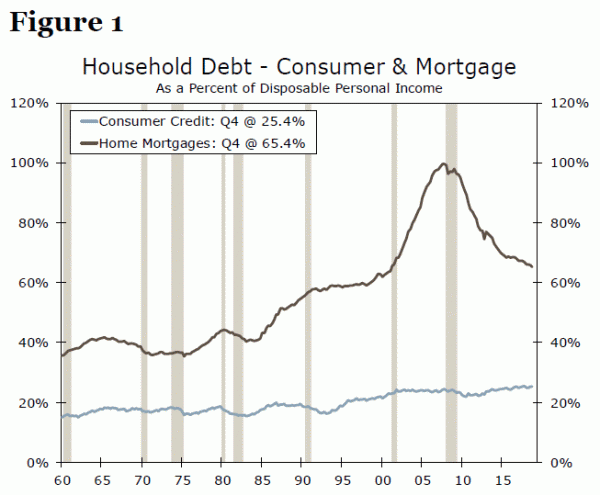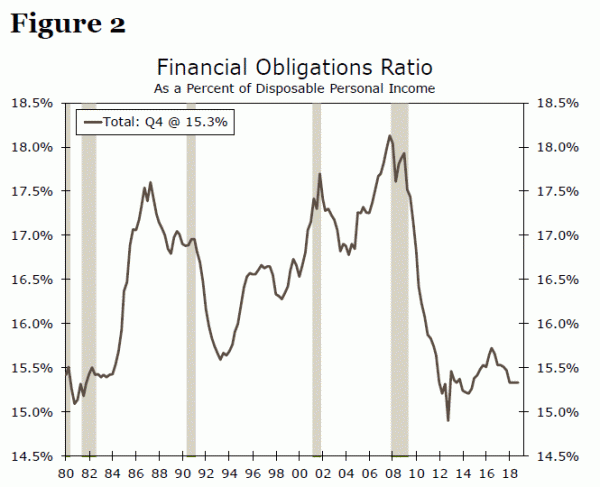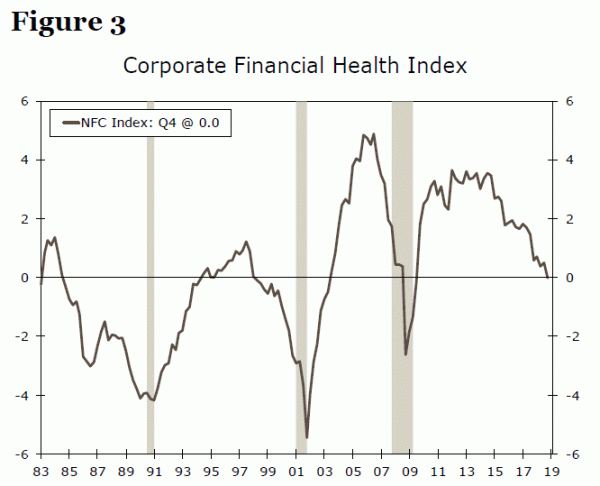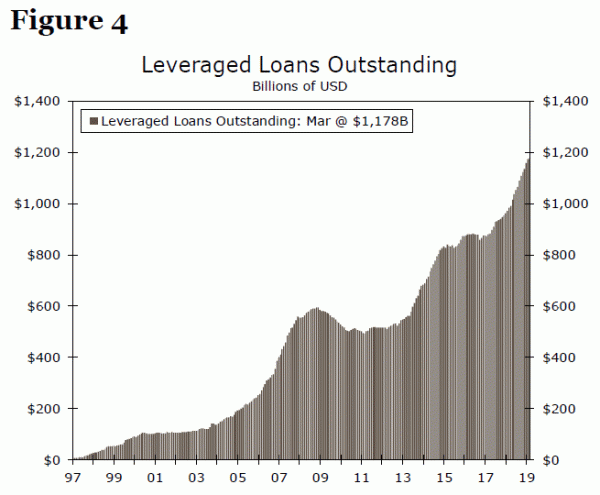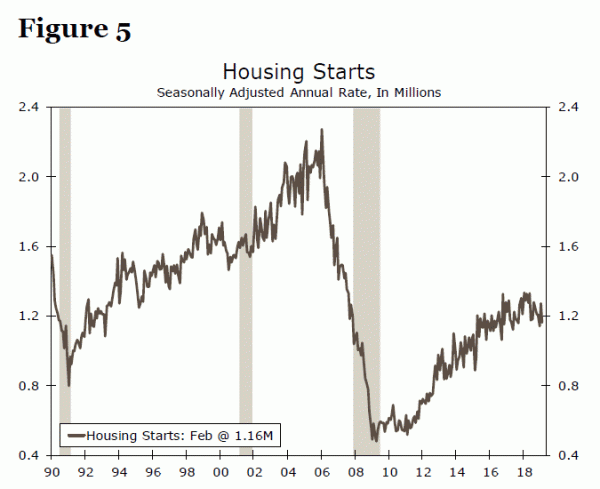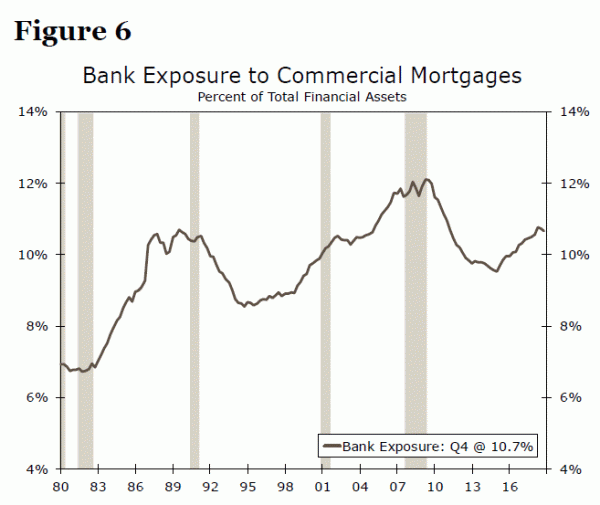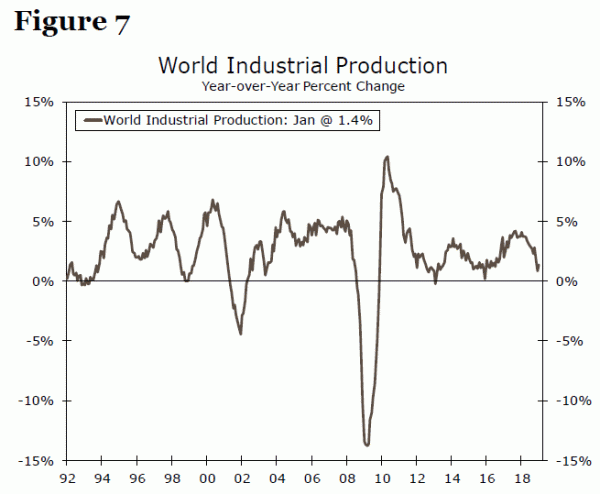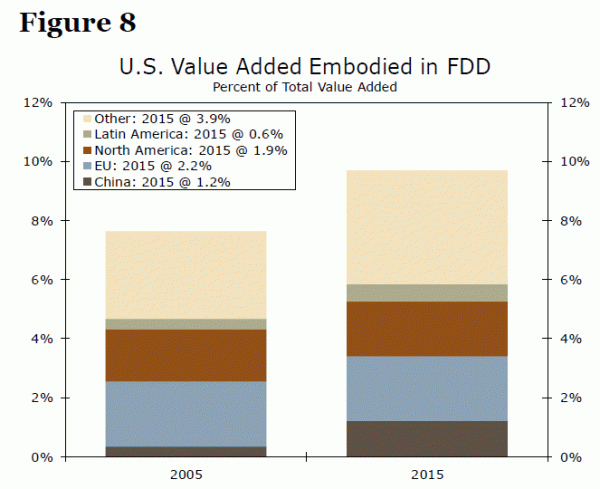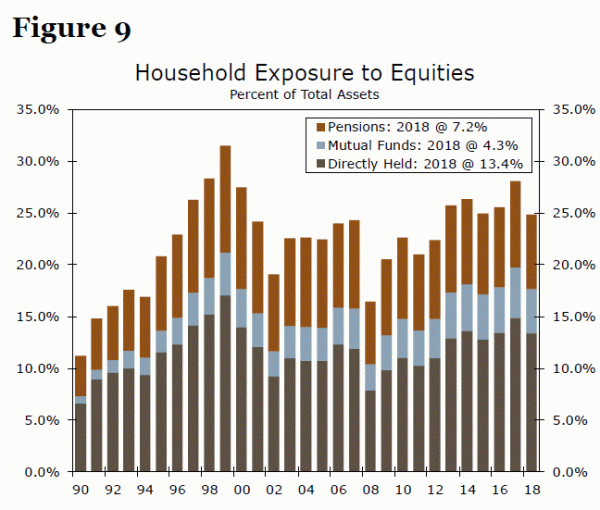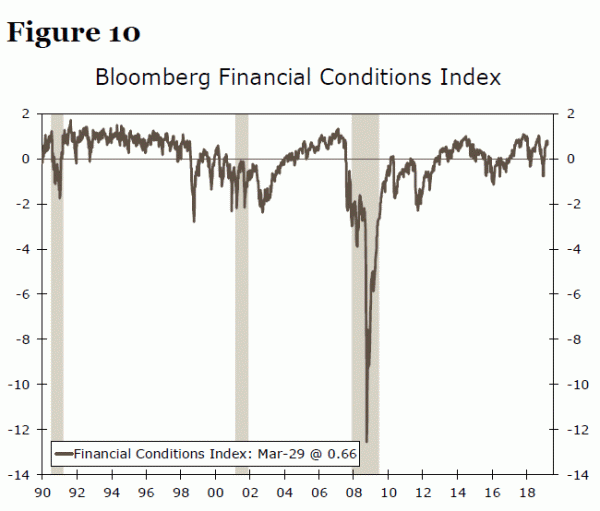Executive Summary
The recent inversion of the yield curve has some observers wondering if a recession in the United States is right around the corner. In our view, talk of an imminent U.S. recession is a bit overdone because the underlying fundamentals of the U.S. economy are generally solid at present. Business sector leverage has risen in recent years, but probably not by enough to lead to recession in the near term, while households have de-levered over the past decade. Growth in many foreign economies has slowed, but it would take a significant downturn in the rest of the world to bring the U.S. economy to its knees. Absent some unforeseen shock, “talking” ourselves into a recession seems to be the most realistic way that the U.S. economy could experience one in the foreseeable future.
How Do Recessions Happen?
The inversion of the U.S. yield curve recently—the yield on the 10-year Treasury security slid below the 3-month T-bill yield on March 22, although the spread has subsequently returned to positive territory—has some observers speculating that a recession is around the corner.1 But economic downturns do not occur in a vacuum. That is, something needs to happen to trigger a recession. In that regard, there are two general catalysts for recession. First, an unforeseen shock (a so-called exogenous shock) can lead to a downturn. For example, the decision by OPEC to embargo oil exports in the wake of the Arab-Israeli War in October 1973 led to a nearly fourfold increase in oil prices. U.S. real GDP subsequently contracted more than 3% between Q4-1973 and Q1-1975.
There have been some disruptions that have hit the economy recently, which we will discuss in more detail subsequently, but none of these shocks rise to the magnitude of the 1973 spike in oil prices. Could another major exogenous shock negatively impact the U.S. economy in the near future? Yes, but exogenous shocks by their very nature are difficult to forecast. Consequently, a forecast of recession that is predicated on some yet-to-occur low-probability exogenous shock is probably not very reliable.
Second, a recession can occur when some sector in the economy becomes unbalanced over time. If the inevitable correction is deep enough and if the sector is large enough, then the entire economy can be dragged down. Examples of these types of recession are the housing boom/bust of the last decade and the “tech wreck” of 2000-2001. So, are there any sectors in the U.S. economy that are out of balance at present? If so, would the inevitable correction in these sectors have the ability to cause a recession in the U.S. economy in the foreseeable future? In the remainder of this report, we analyze different sectors of the economy to determine whether a U.S. recession could emanate therein in the foreseeable future.2
Are Consumer Finances in Good Shape?
Household leverage generally, and mortgage debt specifically, was at the epicenter of the last downturn. Although the severe repercussions of consumers getting over-extended a decade ago may still be fresh in the minds of borrowers, lenders and regulators, overall household leverage has fallen substantially over the past decade (Figure 1). As Mark Twain said, however, history does not repeat, but it often rhymes. Are there other areas in consumer balance sheets that pose a risk to the economy from an extensive build up in debt and deterioration in lending standards?
While mortgage debt has fallen over the past decade, Figure 1 also shows that leverage of other types of consumer debt, including autos, credit cards, and student loans, is at an all-time high. Yet unlike housing debt in the 2000s, the increase has not been exponential. Leverage for consumer credit is also only a quarter of the size of housing-related leverage at the height of the housing bust. What’s more, debt service remains exceptionally low. Historically low interest rates and longer repayment terms have kept households’ monthly financial obligations ratios near levels last seen in the early 1980s (Figure 2).
Notably, the most significant driver of the increase in consumer credit has been student loans. Given that educational debt is nearly impossible to discharge and primarily backed by the federal government, we view student loans as a sustained, long-term headwind to other types of spending rather than a mass credit event that could cause the financial system to seize up like the subprime mortgage crisis. In short, we do not think that consumer debt problems will trigger a recession in the foreseeable future.
Corporate Sector Debt: Keep an Eye on This Space
Where leverage may be more concerning is in the non-financial corporate (NFC) sector. As measured as a percent of GDP, debt in the NFC sector is at a record high. With corporate profit growth slowing, the ability to service debt likely will deteriorate somewhat over the next few quarters. At the same time, a shift in investor sentiment could weigh on asset values, which up until recently had been keeping pace with debt.
The financial health of the business sector has deteriorated since 2015, and significant further deterioration would be worrisome (Figure 3). Firms that are stretched financially may be more reluctant to invest and hire. In addition, if companies start having trouble servicing their debt due to slower growth and/or higher interest costs, rising charge-offs and loan losses could disrupt credit growth. However, the current health of the non-financial corporate sector does not seem particularly dire at present when compared to the late 1980s or ahead of what we consider to have been the business-led recession of 2001.3 Interest rates have been rising from a historically low level and are unlikely to rise much further this cycle, while companies have locked in historically low interest rates by holding more long-term debt.
One segment of business sector debt that bears particularly close watch is the leveraged loan market. Leveraged loans are made to companies with high debt-to-cash flow ratios that are typically rated less than investment grade. Loans outstanding in this sector have grown 35% since 2016, twice as fast as total NFC debt. Slower economic growth this year could make servicing that debt more difficult and lead to weaker demand from investors, which would weigh on credit growth to the business sector and therefore the broader economy. Yet leveraged loans are floating-rate instruments, and, with the Fed currently on hold, interest costs are not expected to shoot markedly higher. As a result, we do not see the leveraged loan market as an immediate threat to the economy.4
Is There Overbuilding in Construction?
The bursting of the U.S. housing market bubble precipitated the Great Recession but it does not seem that lightning will strike twice, at least not in the current cycle. As noted above, households have de-levered over the past ten years. The value of mortgage debt outstanding among households is down 4% relative to its peak in early 2008. But disposable personal income is up 50% over the past ten years, giving households better ability to service that mortgage debt than they had at the height of the housing bubble. Furthermore, single-family housing starts are roughly 50% lower than they were at the height of the housing boom (Figure 5). Although the level of multifamily starts is a bit higher today than it was a decade ago, apartment vacancy rates are low and rent growth remains solid.
Despite indications of robust activity in commercial construction, we do not think that commercial real estate (CRE) is an accident waiting to happen, at least not in the foreseeable future. As we wrote last autumn, the underlying fundamentals in the CRE market appear to be strong.5 Despite appearances of robust construction activity, the level of real non-residential construction spending is only 16% higher today than it was before the economy tumbled into recession in late 2007. At the end of the expansion in the 1980s, real non-residential construction spending was more than 60% higher than its previous peak. Commercial banks hold nearly $1.7 trillion worth of commercial mortgages, an all-time high. However, this amount represents less than 11% of their total financial assets, which is not out of line in a historical context (Figure 6).
Could the Rest of the World Pull Down the U.S. Economy?
Economic growth in foreign economies has slowed over the past few quarters. Global industrial production (IP) was growing roughly 4% on a year-ago basis in early 2018 (Figure 7). At present global IP is up only 1% or so. Some of this loss of momentum represents secular deceleration in China and some other large developing economies. But the direct effects of trade restrictions and the uncertainty regarding the outlook for trade policy arguably have also played a role in slowing the rate of global economic growth. Could slow growth in the rest of the world lead to a U.S. recession?
The value of American exports of goods and services totaled $2.5 trillion in 2018. Yet, the value added (i.e., income) of those exports of goods and services that is embodied in foreign final demand (final sales to foreign households, businesses and governments) represents only 10% of total value added in the U.S. economy. That percentage has grown from less than 8% a decade ago, due in part to strong economic growth in China that has pulled in American goods and, to a lesser extent, services (Figure 8). But with exports accounting for only 10% of U.S. value added, it would take a sharp downturn in the rest of the world to lead to a recession in the United States. Although foreign economic growth has ratcheted down in recent quarters and conceivably could slow further, we forecast that most major economies will not slip into recession in the foreseeable future. In short, the rest of the world can exert a slowing effect on U.S. GDP growth, but those headwinds probably are not strong enough to blow the U.S. economy significantly off course at this time.
Are Financial Market Conditions Restrictive?
The U.S. stock market has encountered some volatility recently for a number of reasons. Could a significant decline in equity prices, should one occur, lead to a U.S. recession? Let’s start with the effect that equity prices have on households. Equities that are directly held account for roughly 15% of household assets (Figure 9). Adding in our estimate of the amount of stocks that people hold in mutual funds and pensions raises exposure to equities to about 25% of total household assets.6 But researchers have generally found that a one dollar change in equity prices causes consumption spending to change by only a few cents.7
But a significant decline in the stock market would raise the cost of capital for firms, which probably would have a depressing effect on investment spending and employment. Furthermore, a swoon in equity prices likely would be associated with a generalized tightening in financial conditions, which would weigh on overall economic activity. Financial markets do not need to seize up entirely à la 2007-2009 to lead to economic weakness (Figure 10). Tightening in financial markets in the wake of the dot-com bust in 2000 contributed to the recession of 2001. At present, financial market conditions generally are accommodative. The stock market remains at a high level, credit spreads generally remain tight and bank lending remains positive. But a significant deterioration in financial market conditions could eventually lead to economic weakness in coming quarters. Clearly, the Federal Reserve could lead to tighter overall financial conditions if it were to significantly raise rates, but Fed policymakers have emphasized recently that they intend to be “patient” in coming months.
Conclusion
In our view, talk of an imminent U.S. recession is a bit overdone. Yes, the yield curve inverted a bit recently. But the underlying fundamentals of the U.S. economy do not indicate that recession is right around the corner, in our view. Household balance sheets are generally solid. Leverage in the NFC sector has risen in recent years, but it probably is not so high now to cause a recession in the near term. Growth in many foreign economies has slowed, but it would take significant downturns in the rest of the world to bring the U.S. economy to its knees.
So what is the most realistic way that the U.S. economy slips into recession in coming months? In the absence of some shock that is unforeseen at this time, the most realistic way for a recession to happen in the foreseeable future is that we simply “talk” ourselves into one. Consumers could hear about prognostications of recession and could stop spending. Businesses could curtail investment and hiring decisions if they surmise that recession is on the way. The stock market would likely weaken, leading to a negative feedback loop. With real GDP growth having slowed already, it may not take much of a risk shock to tip over the economy at this time. In short, expectations of economic weakness could become self-fulfilling. Fortunately, we have never “talked” our way into recession, at least not in living memory. In the immortal words of Franklin Delano Roosevelt, “the only thing we have to fear is fear itself.”
1 See “Inverted Yield Curve: Is It Different This Time?” (March 26, 2019) for a discussion about the reliability of the slope of the yield curve as an indicator of pending recession.
2 For model-based predictions of recession, see “Recession Update: Should We Worry?” (April 1, 2019).
3 See “U.S. Corporate Sector Health: Should We Worry?” (September 27, 2018).
4 See “Leveraged Loans: A Deathknell for the U.S. Economy?” (December 18, 2018).
5 See “Does CRE Pose a Risk to the Financial System?” (November 26, 2018).
6 Pension funds include public and private defined benefit and defined contribution plans.
7 For example, Calomiris, Longhofer and Miles (2012) find that a one dollar change in securities wealth leads to a change in consumption expenditures of only two cents. https://www.nber.org/papers/w17740.pdf




